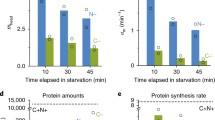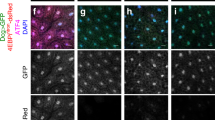Abstract
Amino-acid deprivation is sensed by the eIF2α kinase GCN2. Under conditions of essential amino-acid limitation, GCN2 phosphorylates eIF2α, inhibiting the formation of a new ternary complex and hence mRNA translation initiation. While decreasing global mRNA translation, eIF2α phosphorylation also increases the translation of the integrated stress response (ISR) transcription factor ATF4, which increases the expression of many stress response genes that contain a C/EBP-ATF response element (CARE), including Atf4, 4Ebp1, Asns, and Chop. Using wild-type as well as Gcn2 knockout and unphosphorylatable eIF2α mutant MEFs, we characterized a novel GCN2/eIF2α phosphorylation-independent, but ATF4-dependent, pathway that upregulates the expression of CARE-containing genes in MEFs lacking GCN2 or phosphorylatable eIF2α when these cells are exposed to methionine-deficient, and to a lesser extent arginine- or histidine-deficient, medium. Thus, we demonstrate a GCN2/eIF2α phosphorylation-independent pathway that converges with the GCN2/eIF2α kinase-dependent pathway at the level of ATF4 and similarly results in the upregulation of CARE-containing genes. We hypothesize that the essential role of methionine-charged initiator tRNA in forming ternary complex is responsible for the robust ability of methionine deficiency to induce ATF4 and the ISR even in the absence of GCN2 or eIF2α kinase activity.




Similar content being viewed by others
References
Anthony TG, Reiter AK, Anthony JC et al (2001) Deficiency of dietary EAA preferentially inhibits mRNA translation of ribosomal proteins in liver of meal-fed rats. Am J Physiol Endocrinol Metab 281:E430–E439
B’Chir W, Maurin AC, Carraro V et al (2013) The eIF2α/ATF4 pathway is essential for stress-induced autophagy gene expression. Nucleic Acids Res 41:7683–7699
B’chir W, Chaveroux C, Carraro V et al (2014) Dual role for CHOP in the crosstalk between autophagy and apoptosis to determine cell fate in response to amino acid deprivation. Cell Signal 26:1385–1391
Baird T, Wek R (2012) Eukaryotic initiation factor 2 phosphorylation and translational control in metabolism. Adv Nutr 3:307–321
Dang Do AN, Kimball SR, Cavener DR, Jefferson LS (2009) eIF2alpha kinases GCN2 and PERK modulate transcription and translation of distinct sets of mRNAs in mouse liver. Physiol Genomics 38:328–341
Deval C, Chaveroux C, Maurin AC et al (2009) Amino acid limitation regulates the expression of genes involved in several specific biological processes through GCN2-dependent and GCN2-independent pathways. FEBS J 276:707–718
Dever TE, Hinnebusch AG (2005) GCN2 whets the appetite for amino acids. Mol Cell 18:141–142
Dever TE, Yang W, Aström S et al (1995) Modulation of tRNA(iMet), eIF-2, and eIF-2B expression shows that GCN4 translation is inversely coupled to the level of eIF-2.GTP.Met-tRNA(iMet) ternary complexes. Mol Cell Biol 15:6351–6363
Dey S, Baird TD, Zhou D et al (2010) Both transcriptional regulation and translational control of ATF4 are central to the integrated stress response. J Biol Chem 285:33165–33174
Dong J, Qiu H, Garcia-Barrio M et al (2000) Uncharged tRNA activates GCN2 by displacing the protein kinase moiety from a bipartite tRNA-binding domain. Mol Cell 6:269–279
Donnelly N, Gorman AM, Gupta S, Samali A (2013) The eIF2alpha kinases: their structures and functions. Cell Mol Life Sci 70:3493–3511
Drabkin HJ, Estrella M, Rajbhandary UL (1998) Initiator-elongator discrimination in vertebrate tRNAs for protein synthesis. Mol Cell Biol 18:1459–1466
Francis M, Rajbhandary UL (1990) Expression and function of a human initiator tRNA gene in the yeast Saccharomyces cerevisiae. Mol Cell Biol 10:4486–4494
Grolleau A, Sonenberg N, Wietzerbin J, Beretta L (1999) Differential regulation of 4E-BP1 and 4E-BP2, two repressors of translation initiation, during human myeloid cell differentiation. J Immunol 162:3491–3497
Harding HP, Novoa I, Zhang Y et al (2000) Regulated translation initiation controls stress-induced gene expression in mammalian cells. Mol Cell 6:1099–1108
Hinnebusch AG (2014) The scanning mechanism of eukaryotic translation initiation. Annu Rev Biochem 83:779–812
Jousse C, Averous J, Bruhat A et al (2004) Amino acids as regulators of gene expression: molecular mechanisms. Biochem Biophys Res Commun 313:447–452
Kapp LD, Lorsch JR (2004) GTP-dependent recognition of the methionine moiety on initiator tRNA by translation factor eIF2. J Mol Biol 335:923–936
Kilberg MS, Shan J, Su N (2009) ATF4-dependent transcription mediates signaling of amino acid limitation. Trends Endocrinol Metab 20:436–443
Kolitz SE, Lorsch JR (2010) Eukaryotic initiator tRNA: finely tuned and ready for action. FEBS Lett 584:396–404
Krishnamoorthy T, Pavitt G (2001) Tight binding of the phosphorylated α subunit of initiation factor 2 (eIF2α) to the regulatory subunits of guanine nucleotide exchange factor eIF2B is required for inhibition of translation. Mol Cell Biol 21:5018–5030
Narasimhan J, Staschke KA, Wek RC (2004) Dimerization is required for activation of eIF2 kinase Gcn2 in response to diverse environmental stress conditions. J Biol Chem 279:22820–22832
Palii SS, Kays CE, Deval C et al (2009) Specificity of amino acid regulated gene expression: analysis of genes subjected to either complete or single amino acid deprivation. Amino Acids 37:79–88
Pavitt GD, Ramaiah KVA, Kimball SR, Hinnebusch AG (1998) eIF2 independently binds two distinct eIF2b subcomplexes that catalyze and regulate guanine-nucleotide exchange. Genes Dev 12:514–526
Qiu H, Dong J, Hu C et al (2001) The tRNA-binding moiety in GCN2 contains a dimerization domain that interacts with the kinase domain and is required for tRNA binding and kinase activation. EMBO J 20:1425–1438
Scheuner D, Song B, McEwen E et al (2001) Translational control is required for the unfolded protein response and in vivo glucose homeostasis. Mol Cell 7:1165–1176
Shan J, Ord D, Ord T, Kilberg MS (2009) Elevated ATF4 expression, in the absence of other signals, is sufficient for transcriptional induction via CCAAT enhancer-binding protein-activating transcription factor response elements. J Biol Chem 284:21241–21248
Shan J, Lopez M-C, Baker HV, Kilberg MS (2010) Expression profiling after activation of amino acid deprivation response in HepG2 human hepatoma cells. Physiol Genomics 41:315–327
Sikalidis AK, Lee JI, Stipanuk MH (2011) Gene expression and integrated stress response in HepG2/C3A cells cultured in amino acid deficient medium. Amino Acids 41:159–171
Sikalidis AK, Mazor KM, Kang M et al (2013) Total 4EBP1 is elevated in liver of rats in response to low sulfur amino acid intake. J Amino Acids 2013:864757
Siu F, Bain PJ, Leblanc-Chaffin R et al (2002) ATF4 is a mediator of the nutrient-sensing response pathway that activates the human asparagine synthetase gene. J Biol Chem 277:24120–24127
Sood R, Porter AC, Olsen D et al (2000) A mammalian homologue of GCN2 protein kinase important for translational control by phosphorylation of eukaryotic initiation factor-2α. Genetics 154:787–801
Stolboushkina EA, Garber MB (2011) Eukaryotic type translation initiation factor 2: structure-functional aspects. Biochemistry (Mosc) 76:283–294
Tsukiyama-Kohara K, Vidal SM, Gingras C et al (1996) Tissue distribution, genomic structure, and chromosome mapping of mouse and human eukaryotic initiation factor 4E-binding proteins 1 and 2. Genomics 38:353–363
Tsukiyama-Kohara K, Poulin F, Kohara M et al (2001) Adipose tissue reduction in mice lacking the translational inhibitor 4E-BP1. Nat Med 7:1128–1132
Unbehaun A, Borukhov SI, Hellen CUT, Pestova T V (2004) The 40S subunit in 48S complexes formed at the initiation codon of mRNA is bound to eukaryotic initiation factor (eIF) 3, eIF1, eIF1A, and an eIF2/GTP/Met-tRNA. Genes Dev 3078–3093
Van Der Kelen K, Beyaert R, Inzé D, De Veylder L (2009) Translational control of eukaryotic gene expression. Crit Rev Biochem Mol Biol 44:143–168
Vattem KM, Wek RC (2004) Reinitiation involving upstream ORFs regulates ATF4 mRNA translation in mammalian cells. Proc Natl Acad Sci USA 101:11269–11274
Walter P, Ron D (2011) The unfolded protein response: from stress pathway to homeostatic regulation. Science 334:1081–1086
Wanders D, Stone KP, Forney LA, Cortez CC, Dille KN, Simon J, Xu M, Hotard EC, Nikonorova IA, Pettit AP, Anthony TG, Gettys TW (2016) Role of GCN2-independent signaling through a noncanonical PERK/NRF2 pathway in the physiological responses to dietary methionine restriction. Diabetes 65:1499–1510
Webb BLJ, Proud CG (1997) Eukaryotic initiation factor 2B (eIF2B). Int J Biochem Cell Biol 29:1127–1131
Wek RC, Jackson BM, Hinnebusch AG (1989) Juxtaposition of domains homologous to protein kinases and histidyl-tRNA synthetases in GCN2 protein suggests a mechanism for coupling GCN4 expression to amino acid availability. Proc Natl Acad Sci USA 86:4579–4583
Wek SA, Zhu S, Wek RC (1995) The histidyl-tRNA synthetase-related sequence in the eIF-2 alpha protein kinase GCN2 interacts with tRNA and is required for activation in response to starvation for different amino acids. Mol Cell Biol 15:4497–4506
Wek RC, Jiang H-Y, Anthony TG (2006) Coping with stress: eIF2 kinases and translational control. Biochem Soc Trans 34:7–11
Yamaguchi S, Ishihara H, Yamada T et al (2008) ATF4-mediated induction of 4E-BP1 contributes to pancreatic beta cell survival under endoplasmic reticulum stress. Cell Metab 7:269–276
Zaborske JM, Narasimhan J, Jiang L et al (2009) Genome-wide analysis of tRNA charging and activation of the eIF2 kinase Gcn2p. J Biol Chem 284:25254–25267
Zhang P, McGrath BC, Reinert J et al (2002) The GCN2 eIF2α kinase is required for adaptation to amino acid deprivation in mice. Mol Cell Biol 22:6681–6688
Zhu S, Sobolev AY, Wek RC (1996) Histidyl-tRNA synthetase-related sequences in GCN2 protein kinase regulate in vitro phosphorylation of eIF-2. J Biol Chem 271:24989–24994
Author information
Authors and Affiliations
Corresponding author
Ethics declarations
Conflict of interest
The authors declare that they have no conflict of interest.
Funding
This work was supported by Grants DK-083473 and DK-056649 from the National Institute of Diabetes and Digestive and Kidney Diseases.
Ethical approval
This article does not contain any studies with human participants or animals performed by any of the authors.
Additional information
Handling Editor: H. Jakubowski.
Rights and permissions
About this article
Cite this article
Mazor, K.M., Stipanuk, M.H. GCN2- and eIF2α-phosphorylation-independent, but ATF4-dependent, induction of CARE-containing genes in methionine-deficient cells. Amino Acids 48, 2831–2842 (2016). https://doi.org/10.1007/s00726-016-2318-9
Received:
Accepted:
Published:
Issue Date:
DOI: https://doi.org/10.1007/s00726-016-2318-9




